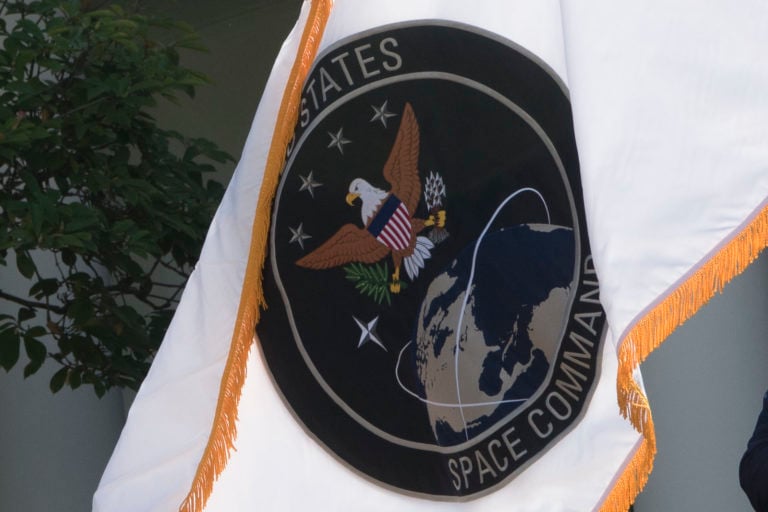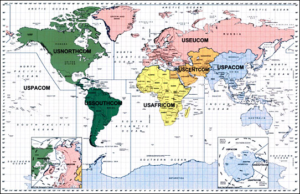By THERESA HITCHENS
 We’ve decided to make it a tradition: partnering with the Center for Strategic and International Studies (CSIS) to bring you their BEST Bad Ideas in national security over the Holiday Season. Given all the folderol last week over the Final Frontier, we’re starting with Kaitlyn Johnson’s critique of the Pentagon’s move to designate the new(ish) Space Command as a geographic command (whose AOR starts 100 kilometers above the Earth’s surface). Instead, CSIS’s Johnson argues, it ought to have been structured as a functional command like Transportation Command, given the nature of the space domain and the types of military operations likely in space. The Editor.
We’ve decided to make it a tradition: partnering with the Center for Strategic and International Studies (CSIS) to bring you their BEST Bad Ideas in national security over the Holiday Season. Given all the folderol last week over the Final Frontier, we’re starting with Kaitlyn Johnson’s critique of the Pentagon’s move to designate the new(ish) Space Command as a geographic command (whose AOR starts 100 kilometers above the Earth’s surface). Instead, CSIS’s Johnson argues, it ought to have been structured as a functional command like Transportation Command, given the nature of the space domain and the types of military operations likely in space. The Editor.
After a 17-year hiatus, the United States Space Command was re-established in 2019 as a new combatant command focused on operations, doctrine, and plans in the space domain. However, unlike its predecessor Space Command from 1985 to 2002, the newly re-established Space Command was deemed a geographic command.
Within the Department of Defense, combatant commands are separated into two categories: geographic and functional. Each command is charged with deploying and operating in their geographic or functional area.
Geographic commands operate in a clearly defined area of responsibility and have a regional-specific focus. The other geographic commands are Central Command, Africa Command, European Command, Northern Command, Indo-Pacific Command, and Southern Command.
Functional commands operate without geographic boundaries and provide unique capabilities to support the geographic commands and other military missions. The functional commands are Special Operations Command, Transportation Command, Strategic Command, and Cyber Command.
Space Command’s area of responsibility (AOR) is defined as the area surrounding Earth at altitudes of 100 kilometers or greater above mean sea level.
Re-establishing Space Command as a geographic command is a bad idea.
One of the distinguishing characteristics of space is that it has no natural boundaries and is inherently international. With the exception of satellites in geosynchronous orbit (GEO), all satellites pass over various parts of the Earth’s surface every day. This physical feature of the domain has led to a unique international approach to space missions, as any country’s satellites have free rights of passage over other nations’ territories. Furthermore, the 1967 Outer Space Treaty, which the United States has ratified, states that “outer space shall be free for exploration and use by all States” and that “outer space is not subject to national appropriation by claim of sovereignty, by means of use or occupation, or by any other means.” From the outset, the international community realized that unlike the air, sea, and land domains where countries can claim sovereign areas, the space domain is inherently international.
So why did the US military re-establish Space Command as a geographic command if there are no distinct territories or regions in space?
The motivations for re-establishing Space Command as its own independent combatant command are instructive. Though distinctly different from the proposed US Space Force, Space Command was elevated out of US Strategic Command in order to address some of the same concerns for military space operations. Foremost, its responsibility is to provide support to other combatant commands and military services who rely on space systems to carry out their missions and daily operations. If the intent of elevating Space Command to an independent combatant command was to improve coordination among the combatant commands and military services, organizing Space Command to focus on a defined AOR does not appear to help mitigate these outstanding issues.
 Yes, there are and will be fully space-based operations and missions. However, because the space domain is an overarching part of operations in all other domains, a conflict in space will likely be tied to a nation or region already supported by a different geographic command. Ground and sea-based attacks against space systems would occur from another geographic command’s AOR. With good attribution and detection capabilities, the United States would first be able to trace an attack to its origin, then decide how to respond – either on Earth or in space. Regardless, Space Command would need to work closely with and support the geographic command(s) that have the AOR of the nation-state attacking the United States in space.
Yes, there are and will be fully space-based operations and missions. However, because the space domain is an overarching part of operations in all other domains, a conflict in space will likely be tied to a nation or region already supported by a different geographic command. Ground and sea-based attacks against space systems would occur from another geographic command’s AOR. With good attribution and detection capabilities, the United States would first be able to trace an attack to its origin, then decide how to respond – either on Earth or in space. Regardless, Space Command would need to work closely with and support the geographic command(s) that have the AOR of the nation-state attacking the United States in space.
Space-to-space attacks are also possible, where one satellite is used to attack another satellite. As a geographic command, the Commander of Space Command would theoretically have the authority to plan and execute a response to a space-to-space attack. This would make Space Command the supported command over the other combatant commands. However, a space-to-space attack is not likely to happen in isolation. It would most likely be conducted by a nation-state in another combatant command’s AOR. In such a scenario, the United States would already be in a conflict or crisis situation with that country, and this attack would be in conjunction with other activities on Earth. With the possibility of American lives and regional security on the line, Space Command would again likely end up being a supporting command to the other geographic command and would ensure that any required space assets or operations were focused on the larger terrestrial mission.
In short, it is difficult to imagine scenarios in which Space Command would be the supported command rather than a supporting command. Why would the new combatant command be structured to focus on the remote possibility of a conflict that is limited only to space and is not part of a larger conflict on Earth? A functional command, which by design is global and structured for supporting the other COCOMs, would be a better fit for Space Command.
In a November 2019 event at the Center for Strategic and International Studies, Gen. Jay Raymond, Commander of US Space Command, discussed that in most cases US Space Command would be a supporting command instead of a supported command. His team is working closely with the other combatant commands to develop both campaign and operational plans for the space domain. Space Command is creating integrated planning elements that live in the other combatant commands to help with this coordination. Completing these plans is of the utmost priority. However, if Gen. Raymond envisions Space Command being in a supporting role, more often than not, rather than having other combatant commands support him, then once again, logic seems to favor a functional command structure.
Re-establishing US Space Command as a geographic command is a bad idea. The responsibilities and missions required of Space Command are a better fit for a command focused on interoperability, support, and coordination with the other combatant commands and military services. Just like the air, sea, and land domains, space is not an independent domain with minimal effects on other domains or operations. It is closely coupled with all other domains across the full spectrum of military missions. It is clear that the Trump Administration recognizes the importance of the space domain and the need to restructure the national security space enterprise to better serve America’s needs; however, it missed the mark by designating Space Command as a geographic command.
No comments:
Post a Comment